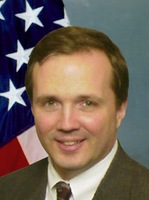News & Events
UV Nanoplasmonics and Applications
Dr. Henry Everitt, Chief Scientist, Army Aviation & Missile RD&E Center
Thursday, April 3, 2014
3:30 p.m.–4:30 p.m.
Sloan Auditorium
Abstract:
Most research in nanoplasmonics has focused
on applications in the visible and near infrared, in large part because the
metals principally used operate there (Au and Ag). However, we are
increasingly interested in exploring plasmonics in the ultraviolet spectral
region, which requires identifying and using new metals that exhibit plasmonic
resonances in the UV and do not parasitically oxidize upon exposure to air or
water. Applications for UV nanoplasmonics include improved analyte recognition
specificity - combining Surface Enhanced Raman Spectroscopy (SERS) with Surface
Enhanced Fluorescence (SEF) - and accelerated photo-degradation of adsorbed
analytes. This talk will introduce our work on UV plasmonics, starting
with an early SEF demonstration involving an InGaN quantum well coupled to a
nearby silver film. The talk will overview theoretical investigations of
various candidate UV plasmonic metals in collaboration with theorists from
Univ. de Cantabria, will emphasize recent work at Duke Univ. on UV SERS, SEF,
and ellipsometric characterization of Ga nanoparticles, and will conclude by
introducing new work on Al-based nanostructures in collaboration with
researchers at Rice University.
Bio:  Dr. Everitt is one of the Army's chief
scientists. He works at the Army's Aviation and Missile RD&E Center at
Redstone Arsenal, AL. Through his adjunct appointment in the Duke Physics
Department, he leads an active experimental research group in condensed matter
physics, nanophotonics, molecular physics, and novel terahertz imaging
with colleagues on campus and through an international network of
collaborators. Four principal research areas are being pursued: ultrafast
spectroscopy, ultraviolet nanoplasmonics, molecular physics, and terahertz
imaging.
Dr. Everitt is one of the Army's chief
scientists. He works at the Army's Aviation and Missile RD&E Center at
Redstone Arsenal, AL. Through his adjunct appointment in the Duke Physics
Department, he leads an active experimental research group in condensed matter
physics, nanophotonics, molecular physics, and novel terahertz imaging
with colleagues on campus and through an international network of
collaborators. Four principal research areas are being pursued: ultrafast
spectroscopy, ultraviolet nanoplasmonics, molecular physics, and terahertz
imaging.
